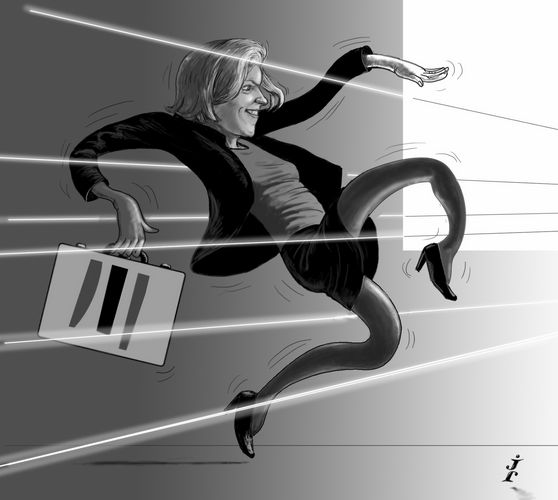Triumph in adversity: “Europe” has been a byword for “risky” in the minds of investors in 2012. The continent’s largest issuers, burdened by their European label, have had to adopt nimble funding strategies. Few entities have done so with the same dexterity and on the same scale as the European Investment Bank, and that is why it is IFR’s SSAR Issuer of the Year.
To see the full digital edition of the IFR Review of the Year, please <a href="http://edition.pagesuite-professional.co.uk//launch.aspx?eid=24f9e7f4-9d79-4e69-a475-1a3b43fb8580" onclick="window.open(this.href);return false;" onkeypress="window.open(this.href);return false;">click here</a>.
Speculation that the European Investment Bank will become increasingly embroiled in rescuing faltering eurozone member states is not new. Since 2010, the EIB has adamantly rejected suggestions its mandate would change, emphasising its role as the bank of the EU.
Its word has held true, but the uncertainty has created an acutely changeable, and at times hostile, market environment.
This is a daunting prospect for any treasury department. Doubly so when you have a €60bn programme to fund.
“At the end of last year we were in a very unusual situation. Spreads had exploded and people were asking whether the sector as a whole would be able to fund itself,” said Eila Kreivi, head of capital markets at the EIB.
“Therefore, when we came into the new year the first thing we did was to establish our market access. From the off, we were extremely active and by the end of the first quarter we had already collected €36bn out of our €60bn programme.”
In the first two weeks of January, the EIB’s outstanding 2.75% €5bn September 2021 bond – a 10-year bond issued in September 2011 – was trading at around a 3% yield. By mid-November, bids for the bond had nearly halved to a low of 1.7%. While yields dropped fairly consistently over the course of the year, it was far from a smooth journey.
During the second quarter, benchmark-sized ventures in the capital markets presented too much in the way of execution risk for the EIB. Instead, the development bank reacted by tapping small pockets of demand – regularly raising over €1bn per week through various increases of outstanding bonds.
Despite this uncertainty, the EIB completed its programme by mid-September – well in advance of European peers like KfW and the EFSF – and began to chip away at its sizeable 2013 funding need.
Diverse and targeted
The EIB has been able to deploy its funding strategy in 2012 through a diverse range of currencies to a wide range of investors.
One of the difficulties the lender has faced is a backlash from US investors towards Europe, which has resulted in a pullback of credit lines for many European public sector issuers. The impact of this is evident in the investor distribution of the EIB bonds in 2012 compared to previous years. US investors bought just 5% of all EIB bonds in 2012, according to its investor presentation updated in September, compared to a 12% share in 2011.
However, rather than exert more pressure on its domestic European investor base, the EIB upped its efforts to market its credit to the Asian investor base. Asian investors bought 37% of EIB bonds in 2012, compared to 30% the year previous.
It was helped in its efforts because, as banks have continued to impose more regulatory discipline, the list of assets which bank treasuries can hold on a zero-risk weighted basis has greatly diminished. The EIB, though, with the backing of its sovereign stakeholders and a Triple A rating, has become a perfect product for bank treasuries. Especially when it still offers some yield pick-up.
In spite of banks clambering to get their hands on its credit, the EIB has been disciplined enough to maintain a broad investor base in line with previous years. Banks bought around 40% of EIB bonds in 2012, but were outgunned by real money investors including fund managers/insurance companies (31%), central banks (26%) and corporates (3%).
When the market turned sour for the EIB, it proved it had many strings to its bow. One of the best examples of this is the use of its Euro-cooperation Bond (or ECoop) programme which allows it to tap ad hoc investor interest in a timely and tailor-made fashion, sizing issue amounts to actual demand.
The beauty of this product is that it is also hugely cost-effective for the issuer. Banks have used the programme to build up a relationship and track-record with the EIB in the hope their loyalty will result in mandates for the larger benchmark Euro Area Reference Note issues.
Some observers have criticised banks for using this programme to do subsidised and uneconomical deals. But as far as the EIB is concerned, ECoops have proven a shrewd way to raise attractive levels with little need to offer new issue premium sweeteners.
“ECoop pricing is a bit more attractive than the benchmarks, but even more importantly it allows us to be flexible and get duration when a €2bn–€3bn benchmark would prove too challenging,” said Kreivi.
EIB issued around €20bn in ECoop bonds in 2012, marginally more than its total EARN issuance, said Kreivi.
Diversity
Outside of euro-denominated issuance, which made up the majority of EIB’s funding in 2012 at 57% – the EIB has also excelled in its US dollar (28%) and sterling issuance (8%) and diversified across a range of other non-core currencies (7%).
The EIB remains among the largest non-US issuers of Global benchmark bonds with US$115bn outstanding across 37 lines with maturities up to 2036. In what was a difficult year for the EIB credit among US investors, it still managed to issue six Global benchmarks and a US$1bn tap, for a total of US$20.5bn. The highlight of those deals was a US$3bn long five-year in July, which gathered US$6.25bn in orders despite banks away from the deal questioning whether there was enough investor demand to muscle the trade through.
EIB’s sterling franchise is even more impressive. The bank is the largest issuer in non-Gilt markets, with a market share that stood at 8.3% of the non-Gilt index at the end of 2011. In 2012, the EIB cemented that position with a further £5bn of issuance.
The highlight of EIB’s sterling issuance in 2012 is the transition in its investor base towards real-money accounts. In 2010 and 2011, banks bought around 50% of EIB sterling issues. In 2012, banks bought just 28%, compared to increased appetite from fund managers/insurance companies/pension funds (40%) and central banks/public institutions (26%).
In the non-core arena, the EIB has been active across a range of currencies including Australian dollars, Turkish lira, Japanese yen, Swiss francs, Norwegian krone, Swedish krona, Russian roubles, Polish zloty, Brazilian Real and South African rand.
Muddle through
Nobody would argue that the EIB had an impeccable issuance record in 2012. It has done its fair share of trickier deals whether it be taps that have come up short of subscription, or benchmarks in testing maturities that have scraped over the line with last minute orders.
But because of its hefty funding programme, the EIB does not always have the luxury to handpick the best windows (unlike many of its peers).
That programme is set to increase in the coming years after its EU shareholders decided to increase the entity’s paid-in capital by €10bn in June. The EIB estimates its funding requirements could increase by up to one-third by 2013, making one of Europe’s heaviest users of the capital markets even heavier.
While the entity is enjoying somewhat of a renaissance coming into the year-end, the nagging doubts about its role within the euro debacle simmer away under the surface.
Even a capital injection that should be viewed as making the outfit more robust, has sparked concerns about what the additional €60bn in long-term lending will be used for.
The funding environment for the EIB in 2013 looks equally fraught, but if its treasury team can muddle through with the same level of innovation and market-savvy it has shown in 2012, it will continue to silence the detractors.



